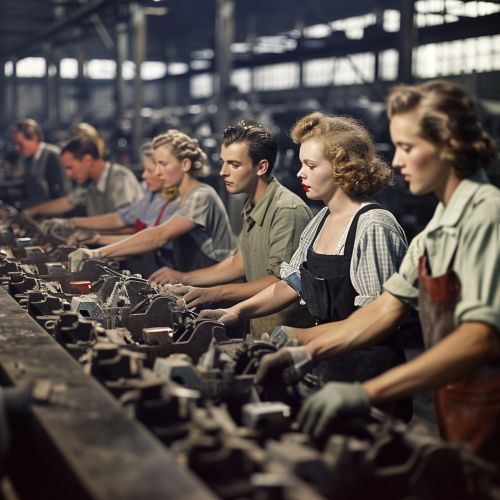Socialist realism
Origins and Development
Socialist realism is a style of idealized realistic art that was developed in the Soviet Union and was the official style in that country between 1932 and 1988, as well as in other socialist countries after World War II. It is characterized by the glorified depiction of communist values, such as the emancipation of the proletariat, by means of realistic imagery.
The term socialist realism was first used by Grigory Zinoviev in a 1922 speech to the Russian Association of Proletarian Writers. However, it did not become the official state doctrine until the Congress of Soviet Writers in 1934. At this congress, four guidelines were laid out for this new artistic movement: proletarian, typical, realistic, and partisan. These guidelines required artists to depict the proletariat's struggle towards socialist progress, to portray characters who were typically proletarian, to use realistic images, and to clearly take the side of the proletariat in the class struggle.


Characteristics and Themes
Socialist realism often depicts workers in an idealized rural or industrial setting. This is intended to show the dignity of labor and the joy of workers in fulfilling their social duty. The art often portrays the collective, with individual identity being minimized in favor of the group's goals.
The themes of socialist realism are often centered around the development of socialist society, the victory of socialist revolution, the transformation of nature by human labor, and the brotherhood of all peoples. The artists were expected to use their work to educate the people in the spirit of socialism.
Influence and Impact
Socialist realism had a profound impact on the artistic community not only in the Soviet Union, but also in other socialist countries. It became the official state art style of the People's Republic of China, North Korea, and Cuba, among others. The style also influenced many artists in Western Europe and the United States, particularly during the 1930s and 1940s.
Despite its restrictions, socialist realism also provided a means for artists to communicate subtly subversive messages. For example, some artists would depict scenes of everyday life that included subtle signs of discontent or hardship, thereby subtly critiquing the state.
Criticism and Controversy
Socialist realism has been criticized for its strict adherence to state doctrine and for its lack of artistic freedom. Critics argue that it is not true art, but rather propaganda for the state. They also argue that the style's emphasis on the collective over the individual stifles creativity and individual expression.
Despite these criticisms, socialist realism remains a significant artistic movement. Its impact on the art world, particularly in the 20th century, is undeniable. It continues to be studied and analyzed by art historians and scholars today.
